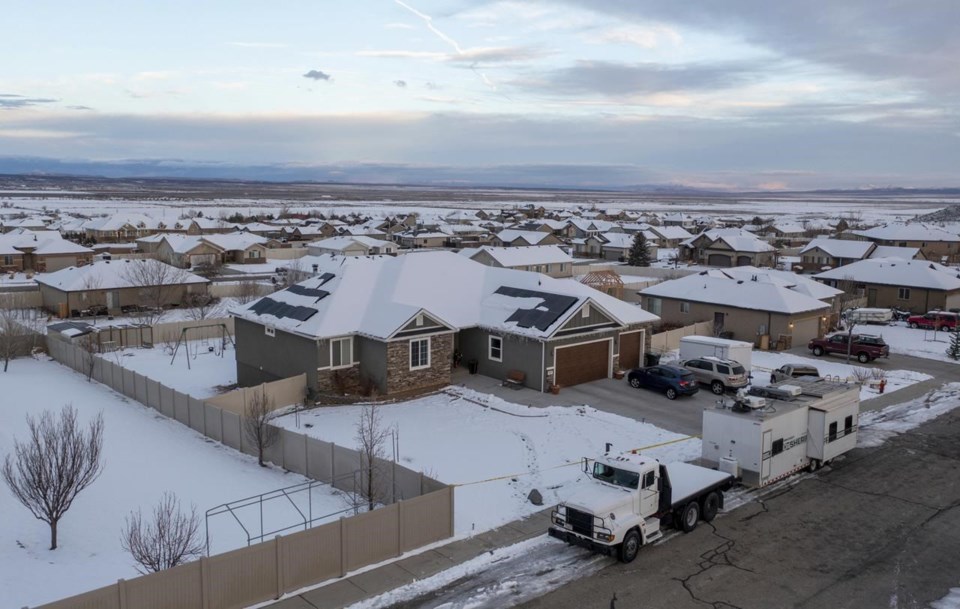ENOCH, Utah (AP) — City leaders in a small Utah town choked up this week as they expressed shock after a murder-suicide carried out by a fellow church member left eight people dead in their close-knit community, including five children who were classmates with their kids.
Though shocking, family mass killings are an all-too-common tragedy across the country. They've happened nearly every 3.5 weeks for the last two decades on average, according to a database compiled by USA Today, The Associated Press and Northeastern University.
Enoch, Utah, is one of more than 30 communities sent reeling by a family mass killing in the last two years, a list that includes communities of wealth and poverty and spares no race or class. A family mass killing — where four or more people were killed, not including the perpetrator — happened each of the last two years in places as large as Houston or as small as Casa Grande, Arizona, the database shows.
The circumstances of the killings are myriad: An argument over pandemic stimulus checks leaves four family members shot dead and two injured in Indianapolis; financial issues lead to authorities finding six children and their parents inside a house set ablaze in Oklahoma; an escalating custody battle in Ohio precedes a man and members of his family shooting the mother of his child and seven of her family members; a father loses his job, piles his wife and kids in the family station wagon and plunges it into the Detroit River.
Motives can remain speculative in family killings in which assailants take their own lives, but police often cite financial or relationship issues as the causes.
Enoch police are still investigating what led to the deaths discovered Wednesday, but authorities said Tausha Haight had recently filed a divorce petition against her husband Michael, a 42-year-old insurance agent who they believe killed her, their five children and Tausha’s mother, who was staying at the family’s home.
Officials have not released information on the weapon they believe killed the adults and the children, who ranged in age from 4 to 17. A relative of Tausha Haight said Friday that the family was left “vulnerable” after Michael Haight removed guns he and his wife owned in the days before the murder-suicide.
Police went to the Haight’s home on Wednesday in response to a welfare check call placed when Tausha Haight missed an appointment.
The news left mothers, fathers, teachers and churchgoers asking a question many communities face in the aftermath of mass shootings: How could this happen here?
City Councilman Rob Jensen said he was well aware such tragedies happen throughout the country, yet that did little to quell the shock he felt when the killings happened in his town.
“Especially in a small town, you don’t anticipate this kind of thing. Nobody does,” Jensen said. “Everyone knows this kind of thing can happen. But everyone wants to say that it’s not them.”
Family mass killings immediately capture the attention of people in a community, but rarely garner the level of national attention received by mass killings at schools, places of worship or restaurants, said James Alan Fox, a criminologist at Northeastern University who has studied familicides and mass killings for decades.
Fox, who helped compile and maintains the database for the AP and USA Today, said that’s because it doesn’t carry the same kind of fear with the public. He noted police often issue messages saying there is no danger to the public shortly after the killings are discovered.
“It’s a nice safe community, but family massacres are independent of the crime rate in the local area,” he said. “We are talking about internal factors, and I think that’s why it’s hard for people to see themselves in these situations and why the response is to mourn instead of fear.”
Family mass killings are in fact the most common type of mass killing, making up about 45% of the 415 mass shootings since 2006, according to the database. They happen twice as frequently as mass shootings in which members of the public are killed.
Most, but not all, involve handguns, only about a third involve households with a previous occurrence of domestic violence and most of the assailants have no violent history or criminal past, Fox said.
There is no governmental agency tracking murder-suicides nationally, so a few years ago policy analysts at the Violence Policy Center — a nonprofit educational organization that conducts research and public education on violence in the U.S. — began tracking details from news accounts to produce an annual report. The latest version from 2020 looked at murder-suicides including many mass killings during the first six months of 2019.
The study found 81% of murder-suicides happened at home and 65% involved intimate partners. The study also found that among murder-suicides where more than three people aside from the assailant were killed, six of the 10 during those six months were incidents in which a person killed their children, partner and themselves.
Fox said most of the killings fall into two categories. The first is murder by proxy, in which the killer is motivated by anger or resentment and kills the children who are seen as an extension of their partner. The second is suicide by proxy motivated by despondency or depression, most often a job loss, and the assailant kills the children as an extension of themselves.
"He wants to spare them the misery of living in this awful world," Fox said. “Over the years, there's been an eclipse in community. There was a time decades ago if you had trouble feeding your family or if you had lost your job, neighbors would come over with casseroles and they would offer emotional support. Many people don’t know their neighbors these days.”
___
Lauer reported from Philadelphia.
Sam Metz And Claudia Lauer, The Associated Press




